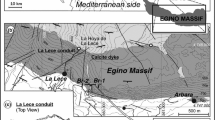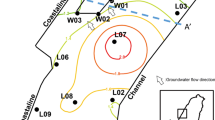Abstract
Stochastic numerical simulations were performed to investigate the evolution of plumes from pulse sources that can result from accidental leaks. The stochastic advection–dispersion equation was solved for hydraulic conductivities typical to the heterogeneous sandy and gravel aquifers encountered in the United Arab Emirates. Dispersivities were similar to those found in field studies at sandy aquifers, such as those conducted at Borden and Cape Cod, and at the Vejen, Denmark tracer tests. Our work showed that the detection probability, Pd, of a monitoring network was affected strongly by the medium’s dispersivity with a large number of wells (larger than 12) required, even in relatively simple geological environments, in order to detect contaminants with confidence. Monitoring systems following minimum regulatory requirements in terms of the number of wells were able to detect contamination at best in only one out of five cases. The frequency of sampling did not appear to be critical when the dispersivity was low and bi-annual sampling appeared to be satisfactory. In highly dispersive media monthly sampling was needed in order to increase detection. Increase of a medium’s dispersivity in relative homogeneous aquifers reduced the performance of large well-systems to less than 50 %. Strongly heterogeneous and dispersive subsurface environments led all monitoring systems to fail in detection, irrespectively of frequency of sampling. Finally, large contaminant quantities did not improve the detection capabilities of low density well-systems with detection enhancements restricted to high density ones.







Similar content being viewed by others
References
Bierkens MFP (2006) Designing a monitoring network for detecting groundwater pollution with stochastic simulation and a cost model. Stoch Environ Res Risk Assess 20:335–351
Bolster D, Barahona M, Dentz M, Fernandez-Garcia D, Sanchez- Vila X, Trinchero P, Valhondo C, Tartakovsky DM (2009) Probabilistic risk analysis of groundwater remediation strategies. Water Resour Res 45(2):W06413. doi:10.1029/2008WR007551
Butera I, Tanda MG, Zanini A (2013) Simultaneous identification of the pollutant release history and the source location in groundwater by means of a geostatistical approach. Stoch Environ Res Risk Assess 27(5):1269–1280
Cirpka OA, Olson A, Qingsong J, Rahman MD, Grathwohl P (2006) Determination of transverse dispersion coefficients from reactive plume lengths. Groundwater 44(2):212–221
Fatta D, Papadopoulos A, Loizidou M (1999) A study on the landfill leachate and its impact on the groundwater quality of the greater area. Environ Geochem Health 21:175–190
Garabedian SP, LeBlanc DR, Gelhar LW, Celia MA (1991) Large-scale natural gradient tracer test in sand and gravel, Cape Cod, Massachusetts, 2, Analysis of spatial moments for a nonreactive tracer. Water Resour Res 27:911–924
Huang C, Hu BX, Li X, Ye M (2009) Using data assimilation method to calibrate a heterogeneous conductivity field and improve solute transport prediction with an unknown contamination source. Stoch Environ Res Risk Assess 23(8):1156–1167
Hudak PF (2005) Sensitivity of groundwater monitoring networks to contaminant source width for various seepage velocities. Water Resour Res 41:W08501. doi:10.1029/2005WR003968
Hudak PF, Loaiciga HA (1992) A location modeling approach for groundwater monitoring network augmentation. Water Resour Res 28(3):643–649. doi:10.1029/91WR02851
Jensen KH, Bitsch K, Bjerg PL (1993) Large-scale dispersion experiments in a sandy aquifer in Denmark: observed tracer movements and numerical analyses. Water Resour Res 29(3):673–696
Kendall CGStC, Sadd JL, Alsharhan AS (1994) Holocene marine cement coating on beach-rocks of the Abu Dhabi coastline (UAE); Analogues for cement fabrics in ancient limestones. Carbonates Evaporites 9(2):119–131
Kendall CGStC, Alsharhan AS, Cohen A (2002) The Holocene tidal flat complex of the Arabian Gulf Coast of Abu Dhabi. In: Barth HJ, Boer B (eds) Sabkha ecosystems. Kluwer Academic Publishers, Netherlands, pp 21–35
Kim K-H, Lee KK (2007) Optimization of groundwater-monitoring networks for the identification of the distribution of a contaminant plume. Stoch Environ Res Risk Assess 21(6):785–794
Ko N-Y, Lee K-K (2010) Information effect on remediation design of contaminated aquifers using the pump and treat method. Stoch Environ Res Risk Assess 24(5):649–660
Lerche I, Paleologos EK (2002) Control function measures for hydrodynamic problems. Math Geol 34(3):345–355. doi:10.1023/A:1014899024189
Mantoglou A (1987) Digital simulation of multivariate two- and three-dimensional stochastic processes with a spectral turning bands method. Math Geol 19(2):129–149
McLaughlin D, Reid LB, Shu-Guang L, Hyman J (1993) A Stochastic method for characterizing ground-water contamination. Ground Water 31(2):237–249
Menche PJ (2010) Strategic water storage/recovery project in Liwa. “Water Days” Conference, Abu Dhabi, June 2010
Meyer PD, Valocchi AJ, Eheart JW (1994) Monitoring network design to provide initial detection of groundwater contamination. Water Resour Res 30(9):2647–2659. doi:10.1029/94WR00872
Mukhopadhyay A, Al-Sulaimi J, Barrat JM (1994) Numerical modeling of ground-water resource management options in Kuwait. Groundwater 32(6):917–928
Murad AA, Krishnamurthy RV (2004) Factors controlling groundwater quality in Eastern United Arab Emirates: a chemical and isotopic approach. J Hydrol 286:227–235
National Research Council (NRC) (1994) Alternatives for groundwater cleanup. National Academy Press, Washington, D.C., p 336
National Research Council (NRC) (1999) Groundwater and soil cleanup: improving management of persistent contaminants. National Academy Press, Washington, D.C., p 304
Neuman SP (1990) Universal scaling of hydraulic conductivities and dispersivities in geologic media. Water Resour Res 26(8):1749–1758
Neuman SP (2003) Maximum likelihood Bayesian averaging of uncertain model predictions. Stoch Environ Res Risk Assess 17(5):291–305
Papapetridis K, Paleologos EK (2011) Contaminant detection probability in heterogeneous aquifers and corrected risk analysis for remedial response delay. Water Resour Res 47(10):15. doi:10.1029/2011WR010652
Renou S, Givaudan JG, Polain S, Dirassouyan F, Moulin P (2008) Landfill leachate treatment: Review and opportunity. J Hazard Mater 150:468–493. doi:10.1016/j.jhazmat.2007.09.077
Rizk ZS, Alsharhan AS (2003). Water resources in the United Arab Emirates. In: Alsharhan AS, Wood WW (eds) Water resources perspectives: evaluation, management and policy, Developments in Water Series #50, Elsevier Publishers: 245–264
Salamon P, Fernandez-Garcia D, Gomez-Hernandez JJ (2006a) A review and numerical assessment of the random walk particle tracking method. J Contam Hydrol 87:277–305. doi:10.1016/j.jconhyd.2006.05.005
Salamon P, Fernandez-Garcia D, Gomez-Hernandez JJ (2006b) Modeling mass transfer processes using random walk particle tracking method. Water Resour Res 42:W11417. doi:10.1029/2006WR004927
Sanford WE, Wood WW (2001) Hydrology of the coastal sabkhas of Abu Dhabi, United Arab Emirates. Hydrogeology 9:358–366
Sarris TS, Paleologos EK (2004) Numerical investigation of the anisotropic hydraulic conductivity behavior in heterogeneous porous media. Stoch Environ Res Risk Assess 18:188–197
Schulze-Makuch D (2005) Longitudinal dispersivity data and implications for scaling behavior. Ground Water 43(3):443–456
Shi L, Zeng L, Tang Y, Chen C, Yang J (2013) Uncertainty quantification of contaminant transport and risk assessment with conditional stochastic collocation method. Stoch Environ Res Risk Assess 27(6):1453–1464
Spitz K, Moreno J (1996) A practical guide to groundwater and solute transport modeling. John Wiley & Sons, New York, p 461
Storck P, Eheart JW, Valocchi AJ (1997) A method for the optimal location of monitoring wells for detection of groundwater contamination in three-dimensional heterogeneous aquifers. Water Resour Res 33(4):2081–2088. doi:10.1029/97WR01704
Sudicky EA (1986) A natural gradient experiment on solute transport in a sand aquifer: spatial variability of hydraulic conductivity and its role in the dispersion process. Water Resour Res 22(13):2069–2082. doi:10.1029/WR022i013p02069
Tartakovsky DM (2007) Probabilistic risk analysis in subsurface hydrology. Geophys Res Lett 34:L05404. doi:10.1029/2007GL029245
Tompson AFB, Ababou R, Gelhar LW (1989) Implementation of the three- dimensional turning bands random field generator. Water Resour Res 25(10):11. doi:10.1029/WR025i010p02227
Uffink GJM (1990). Analysis of dispersion by the random walk method. Ph.D. Thesis, Delft University of Technology, Delft
Wang H, Jin X (2013) Characterization of groundwater contaminant source using Bayesian method. Stoch Environ Res Risk Assess 27(4):867–876
Winter CL, Tartakovsky DM (2008) A reduced complexity model for probabilistic risk assessment of groundwater contamination. Water Resour Res 44:W06501. doi:10.1029/2007WR006599
Wood WW, Rizk ZS, Alsahrhan AS (2003). Timing of recharge, and the origin, evolution, and distribution of solutes in a hyperarid aquifer system. In: Alsharhan AS, Wood WW (eds.), Water resources perspectives: evaluation, management and policy, Developments in Water Series #50, Elsevier Publishers: 295–312
Woodbury AD, Sudicky EA (1991) The geostatistical characteristics of the Borden aquifer. Water Resour. Res 27(4):533–546. doi:10.1029/90WR02545
Yenigül NB, Elfeki AMM, Gehrels JC, Akker C, Hensebergn AT, Dekking FM (2005) Reliability assessment of groundwater monitoring networks at landfill sites. J Hydrol 308:1–17. doi:10.1016/j.jhydrol.2004.10.017
Yenigül NB, Elfeki AMM, Van den Akker C, Dekking FM (2006) A decision analysis approach for optimal groundwater monitoring system design under uncertainty. Hydrol Earth System Sci Discuss 3:27–68
Yenigül NB, Hensberggen AT, Elfeki AMM, Dekking FM (2011) Detection of contaminant plumes released from landfills: Numerical versus analytical solutions. Environ Earth Sci 64:2127–2140. doi:10.1007/s12665-011-1039-3
Zhang Y-K, Neuman SP (1990) A quasi-linear theory of non-Fickian and Fickian subsurface dispersion, 1, Application to anisotropic media and the Borden site. Water Resour Res 26(5):903–913
Zhang D, Shi L, Chang H, Yang J (2010) A comparative study of numerical approaches to risk assessment of contaminant transport. Stoch Environ Res Risk Assess 24(7):971–984
Acknowledgments
This work was partially supported by Abu Dhabi University Research Grant 1920109 to the first author. The authors would like to thank the Associate Editor and an anonymous reviewer for their constructive comments that improved our manuscript.
Author information
Authors and Affiliations
Corresponding author
Rights and permissions
About this article
Cite this article
Paleologos, E.K., Papapetridis, K. & Kendall, C.G.S.C. Stochastic contaminant transport monitoring in heterogeneous sand and gravel aquifers of the United Arab Emirates. Stoch Environ Res Risk Assess 29, 1427–1435 (2015). https://doi.org/10.1007/s00477-014-0983-3
Published:
Issue Date:
DOI: https://doi.org/10.1007/s00477-014-0983-3




